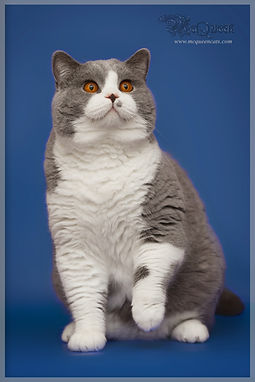



Over the years we have not only shriven to perfect our “Teddy” look, but also an endless variety of Rare British Coat Colors and Patterns. Our wide color pallet is like no other cattery in the world. We invite you to enjoy the photos below to see some of the luxurious color combinations we have achieved here at our cattery. Each of the cat you see below is unique and special; often imitated and never duplicated! The pictures contained within are some of our past kittens. We hope you enjoy our endless array of color combinations.
We will be slowly adding sample pictures below. Please feel free to email a picture of your British to be considered for showing here.
British Cats' Colors & Patterns
British Shorthair Colors

Classic Blue
Classic blue is a true signature of British breed. Blue kittens, often called grey feature a beautiful solid coat ranging from a light pastel blue to a deep slate grey. These cats have either brilliant copper colored eyes as matured.
One of the largest breeds of cat, this British favorite has been developed in a variety of attractive colors.
Tabby
Although the British Shorthair is the most even-tempered of cats, this variation is a reminder of its wild tabby-patterned ancestors. Brown tabbies were among the first British Shorthairs to appear in cat shows in the 1870s, and red and silver versions became popular early on in the breed's history. This cat now comes in a wide range of additional colors, with three traditional tabby patterns: classic (or blotched) tabby, with markings arranged in broad whorls; mackerel, with narrower markings; and spotted. In the Tortie-Tabby, the coat has a second ground color.



Bi-Color
Black and white British Shorthairs were much valued in the 19th century when this breed had its beginnings, but they were never common. The Bicolor as it is today, which comes in several combinations of white and another color, was not fully developed until the 1960s. At that time, almost impossibly high breeding standards required the color patches to be distributed over head and body with complete symmetry. The rules have since been relaxed, but the best Bicolors still have strikingly even markings.
Blue - Cream
"The mingled colors in this cat's coat give the breed an unusual marbled appearance."
In a tortoiseshell (tortie), two coat colors are softly blended. There are many variations, but the most common is black mixed with red - the first tortie color to be developed in British Shorthairs. Bluecream tortoiseshell, in which black is replaced by blue and red by cream, is another of the older colors, recognized since the 1950s. In the Tortie and White (known as Calico) the colors are more clearly defined as patches. For genetic reasons, tortoise are nearly always female and the few males are sterile.


White
"This traditional breed, with a new look, loves children and gets along with dogs, making it an ideal housecat"
Cream kitten Adopted by Prince Abdulrahman bin Khalid Al Saud
Cream
These creamy luxurious angels are simply adorable in every way!



Silver Tabby
The "bullseye" pattern of the classic tabby is seen here to advantage on a British Shorthair. The breed was the model for the Cheshire Cat illustrations in Alice's Adventures in Wonderland.
Black
Self Black Brits have become incredibly rare. We strive to get one or two each year for those of you who have a passion for this mysterious & beautiful British Shorthair.


"This Black Panther has plush fur and striking copper eyes"
